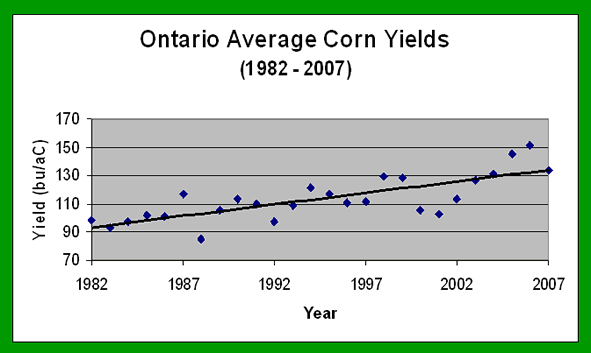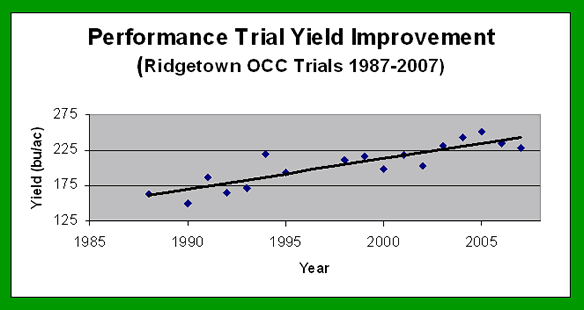
25 Years of Corn Yield Improvement
Since 1983, corn yields in the province have increased dramatically, with year over year increases averaging nearly 2 bushels per acre (see Figure 1). Several factors have contributed to this yield improvement including agronomic and genetic improvements.

Agronomics
What are Ontario corn producers doing better today than they did 25 years ago? Driven by our relatively short growing season earlier corn planting has been aggressively pursued by many growers. More tile drainage, bigger planters and more planting in April are all matters farmers have taken into their own hands to squeeze more bushels of corn out of an Ontario summer.
In addition to planting earlier, corn planting has been done with increased precision. Equipment improvements and producer attention is resulting in greater uniformity in the corn field. Greater uniformity in the seed bed, in seed placement and in the seed spacing coupled with higher seeding rates continue to push corn yields upwards.
The industry has also really worked together well on improving weed control in corn in Ontario. New products, herbicide tolerant hybrids, research on weed control timing, better matching of problem weeds with the most appropriate herbicides and excellent information transfer to producers
have all contributed to improving corn yields through better weed control.
Genetics
The upward climb in corn yields has of course been driven by improved genetics. At the Ontario Corn Committee performance trials management has been fairly precise and constant over the last two decades. Hence, much of the gain at these sites is reflective of the improved genetic potential of the hybrids. At a typical performance trial location the increase in yields over the last 20 years has been more than 4 bu/acre (see Figure 2). Most would agree that the vast majority of that increase has been genetic. But how? Where has the yield come from?

Dr. M Tollenaar, University of Guelph has been tackling this question for the last 25 years. His synopsis is that two significant changes have occurred in corn hybrids to generate more grain yield. Firstly, under similar growing conditions new hybrids have the ability to set more kernels per ear than did old hybrids and secondly the newer hybrids have the ability to fill those kernels more efficiently and under a range of stresses from high density, to cooler temperatures, to drought. Tollenaar refers to this “general stress tolerance” as the key to yield improvement, and in his opinion certainly more important than any other development to date.
Intrigued by stress tolerance one can look at corn yields in particularly stressful years. The two that come to mind most readily are the years of 1988 and 2007, both abnormally dry. In 1988 the yields sank to 85 bushels per acre, significantly below what the trend line would have indicated. In 2007, with arguably conditions as dry or drier than 1988 Ontario recorded the third highest yield ever at 135 bu/acre (see Table 1). Some might contend that the 2007 yields slid significantly from the record highs of 2005 and 2006 but considering the rainfall pattern it still was a surprise to most that yields were so high given the stress the most of the crop was under throughout the 2007 growing season.
Table 1. Comparison of corn grain yields in 1988 versus 2007 |
||
1988 |
2007 |
|
Provincial Average |
85 |
134 |
| Ridgetown OCC Performance Trial Average | 163 |
228 |
| Ridgetown Highest Trial | 182 |
255 |
| Elora OCC Performance Trial average | 138 |
199 |
| Elora Highest Yield | 166 |
245 |
| Ottawa OCC Performance Trial Average | 146 |
223 |
| Ottawa Highest Yield | 171 |
263 |
Where Now?
These are exciting times for producers considering the future of corn yields. There seems to be no room for complacency or pessimism. The demand for corn continues to grow. Seed companies are promising yield trend lines to soar upwards. Producers who 25 years ago would have been excited by 150 bushels per acre, now have sights set at 200 bushels and the target is on the move!